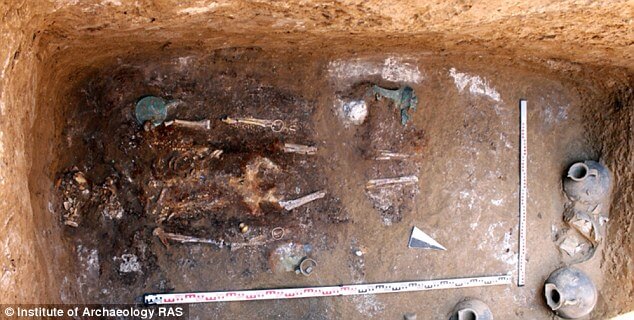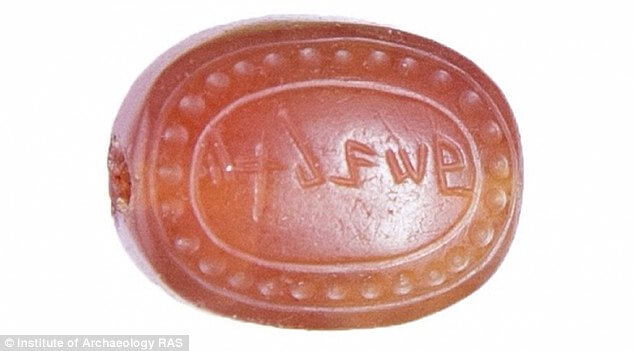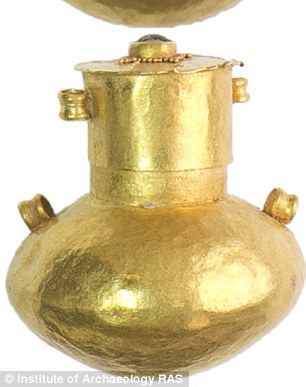Excavations In Russia Revealed A Hebrew Seal
An astonishing hoard of valuables has recently been unearthed from the grave of a noble female warrior, dating back to the first century AD. The intactness of the burial mound led archaeologists to believe it is ‘invaluable’.
The female warrior belonged to the Sarmatians, who worshipped fire and had outstanding performance in battles that inspired the creation of Amazons in Greek mythology.
Between the 6th and 4th centuries BC, the Sarmatians were known as nomads migrating from central Asia to the Ural mountains, famous for being fierce warriors who fought on horseback and sacrificed horses to their fire god.
On the warrior woman’s chest lied a gem with a single-line Phoenician or early Aramaic engraved upon. Her grave and treasures are among the 29 burial mounds unearthed during the building of a new aviation facility serving Rostov-on-Don.
Archaeologist Roman Mimokhod said: ‘Most of the burials on this site are plundered and, of course, it is great luck to find an intact one. ‘It is interesting that there are two burials in this mound. One obviously belonged to man and was totally looted.
There were gold earrings with pendant chains placed beside the warrior’s skull. Speaking of this, Mimokhod stated that they believed it was a double burial of some noble Sarmatian and his wife. He also noted that archaeologists will soon carry out specific analysis on the warrior’s remnants and reveal the outcome at a later time.
The tomb is 13 ft. (4 m) deep, covered with a wooden decking. As mentioned above, scientists discovered the remains of a horse harness and more than 100 iron arrowheads at the edge of the grave pit, indirectly confirming what prehistoric chroniclers wrote about the Sarmatians – hostilities.
‘This had a tight lid and its contents are fossilised. We will analyse this to understand what it was, but most likely it contained some incense. By her right hand were fragments of wooden dishes and a cup,’ he added.
There were also pieces of a copper bucket with flower ornaments and the picture of the head of the Gorgon on a stick. There were also 4 ceramic vessels in the north-eastern part of the grave.
‘This can mean that the most ancient things were handed down for a long time and finally were buried with this noble woman.’ The Sarmatians flourished from the 5th century BC to the fourth century AD.
 Source: Institure of Archaeology RAS
Source: Institure of Archaeology RAS
The female warrior belonged to the Sarmatians, who worshipped fire and had outstanding performance in battles that inspired the creation of Amazons in Greek mythology.
Between the 6th and 4th centuries BC, the Sarmatians were known as nomads migrating from central Asia to the Ural mountains, famous for being fierce warriors who fought on horseback and sacrificed horses to their fire god.
 Source: Institure of Archaeology RAS
Source: Institure of Archaeology RAS
On the warrior woman’s chest lied a gem with a single-line Phoenician or early Aramaic engraved upon. Her grave and treasures are among the 29 burial mounds unearthed during the building of a new aviation facility serving Rostov-on-Don.
Archaeologist Roman Mimokhod said: ‘Most of the burials on this site are plundered and, of course, it is great luck to find an intact one. ‘It is interesting that there are two burials in this mound. One obviously belonged to man and was totally looted.
 Source: Institure of Archaeology RAS
Source: Institure of Archaeology RAS
There were gold earrings with pendant chains placed beside the warrior’s skull. Speaking of this, Mimokhod stated that they believed it was a double burial of some noble Sarmatian and his wife. He also noted that archaeologists will soon carry out specific analysis on the warrior’s remnants and reveal the outcome at a later time.
The tomb is 13 ft. (4 m) deep, covered with a wooden decking. As mentioned above, scientists discovered the remains of a horse harness and more than 100 iron arrowheads at the edge of the grave pit, indirectly confirming what prehistoric chroniclers wrote about the Sarmatians – hostilities.
 Source: Institure of Archaeology RAS
Source: Institure of Archaeology RAS
‘This had a tight lid and its contents are fossilised. We will analyse this to understand what it was, but most likely it contained some incense. By her right hand were fragments of wooden dishes and a cup,’ he added.
There were also pieces of a copper bucket with flower ornaments and the picture of the head of the Gorgon on a stick. There were also 4 ceramic vessels in the north-eastern part of the grave.
 Source: Institure of Archaeology RAS
Source: Institure of Archaeology RAS
‘This can mean that the most ancient things were handed down for a long time and finally were buried with this noble woman.’ The Sarmatians flourished from the 5th century BC to the fourth century AD.
Share this article
Advertisement